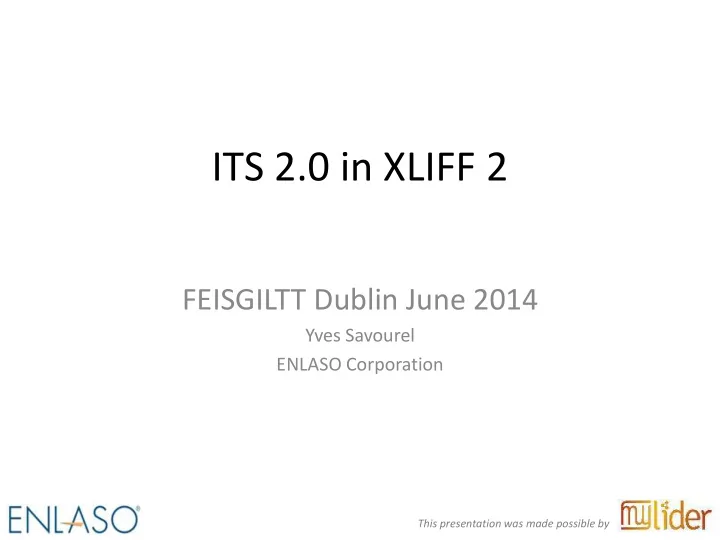

ITS 2.0 in XLIFF 2 FEISGILTT Dublin June 2014 Yves Savourel ENLASO Corporation This presentation was made possible by
Why the mapping? • ITS 2.0 provides many data categories that match or complete XLIFF metadata. • ITS 2.0 has a mapping to XLIFF 1.2 Having a mapping for XLIFF 2 make sense • Mapping done by the ITS Interest Group http://www.w3.org/International/its/wiki/XLIFF_2.0_Mapping • Goal is to create a new XLIFF 2 module
Types of mapping • Data categories not used directly in XLIFF (typically non-metadata data categories e.g. Id Value) • Use existing XLIFF metadata: e.g. Translate • Use ITS markup directly: e.g. Text Analysis • Use a mixed mapping: e.g. Terminology
Marker type • Use type="its:any" in most cases • Mix of data categories can share one annotation of type its:any • Any data category that can use its:any can use other marker types too • Exceptions: – Terminology (only type: term or its:term-no ) – Localization Note (only type: comment )
Translate • The XLIFF translate attribute has the exact same syntax and semantics as in ITS. • In <file> , <group> , <unit> and <mrk> / <sm/> elements. • Example
Localization Note • <mrk type="comment"> with either a value attribute or a ref attribute. • Note that ref attribute must point to an internal <note> within the unit • priority="1" is locNoteType="alert" , other priority values map to "description"
Terminology • <mrk type="term" …> with ref mapping to its:termInfoRef • istxlf:termConfidence for its:termConfidence • Use type="its:term-no" for its:term="no" • Challenging to implement because mix of Core + ITS features (3 different namespaces) • Example
Directionality • Not mapped yet • XLIFF 2.0 has srcDir , trgDir , dir (values: ltr , rtl or auto ) • Inside content: uses Unicode control characters
Language Information • In <xliff> element: – Use xliff@srcLang for the source language – Use xliff@trgLang for the target language • Inline: – Use xml:lang in <mrk>
Elements Within Text • Not used directly in XLIFF, but it drives what XLIFF element is used when extracting: • withinText="no" : go to <unit> • withinText="yes" : go to <pc> , <sc> , <ec> or <ph> • withinText="nested" : go to separate <unit> . With subFlows attribute in parent.
Domain • Use istxlf:domains attribute. • In <unit> and <mrk> elements • Example
Text Analysis • Use ITS native attributes. • In <mrk> element. • Example
Locale Filter • Use ITS native attributes • Add translate="yes|no" if the annotation is generated when the target language of the document is known. • In <unit> and <mrk> elements.
Provenance • Use ITS native attributes and elements. • Stand-off elements at the <unit> level. Or should it be at the <file> level? • Applies to the target content: Single instance or reference to stand-off list in <mrk type="its:any"> element. • Example
External Resource • Not mapped yet • Mapping would likely be related to the Resource Data module.
Target Pointer • Target of the original document is in the <target> elements. selector="//xlf:unit/xlf:source" targetPointer="../xlf:target"
Id Value • Use the name attribute of the <unit> element to store the original ID values • Using Id Value data category on XLIFF is not really useful as there are no document-wide unique IDs.
Preserve Space • Use xml:space like ITS • In <mrk> and <unit> elements • Note that <data> is by default xml:space="preserve" while other elements inherit from parents (and <xliff> default is xml:space="default"
Localization Quality Issue • Use ITS native attributes • In <mrk> elements, with stand-off notation at the <unit> level. • Example
Localization Quality Rating • Not mapped yet • In some aspects similar to <match> ’s matchQuality (which is mapped to MT Confidence) • But has two representations: a score and a number of votes, so using the native ITS attributes may be simpler
MT Confidence • In the Translation Candidates module: – Use matchQuality (scaled to 0.0-100.0) – In <match> element • Normal inline content: – Use ITS native attributes – In <mrk> element • Example
Allowed Characters • Use ITS native attributes • In <mrk> element • Example
Storage Size • Not mapped yet • To map with the Size and Length Restriction module
A few links • ITS 2.0 Specification http://www.w3.org/TR/its20/ • XLIFF 2.0 Specification http://docs.oasis-open.org/xliff/xliff-core/v2.0/xliff-core-v2.0.html • ITS 2.0 mapping for XLIFF 2: http://www.w3.org/International/its/wiki/XLIFF_2.0_Mapping • Okapi XLIFF Toolkit (implements the mapping): https://code.google.com/p/okapi-xliff-toolkit/wiki/ITS
Recommend
More recommend